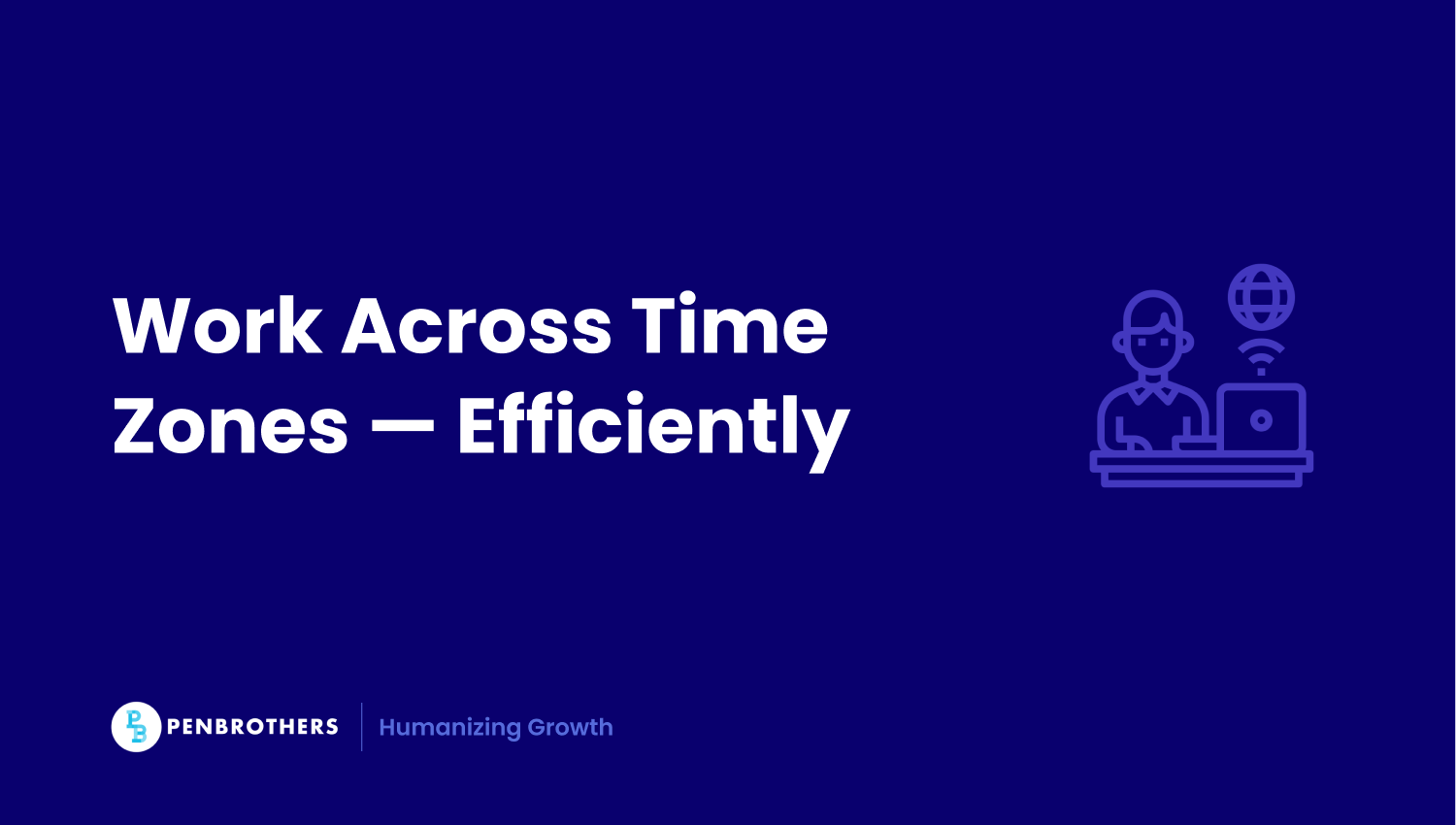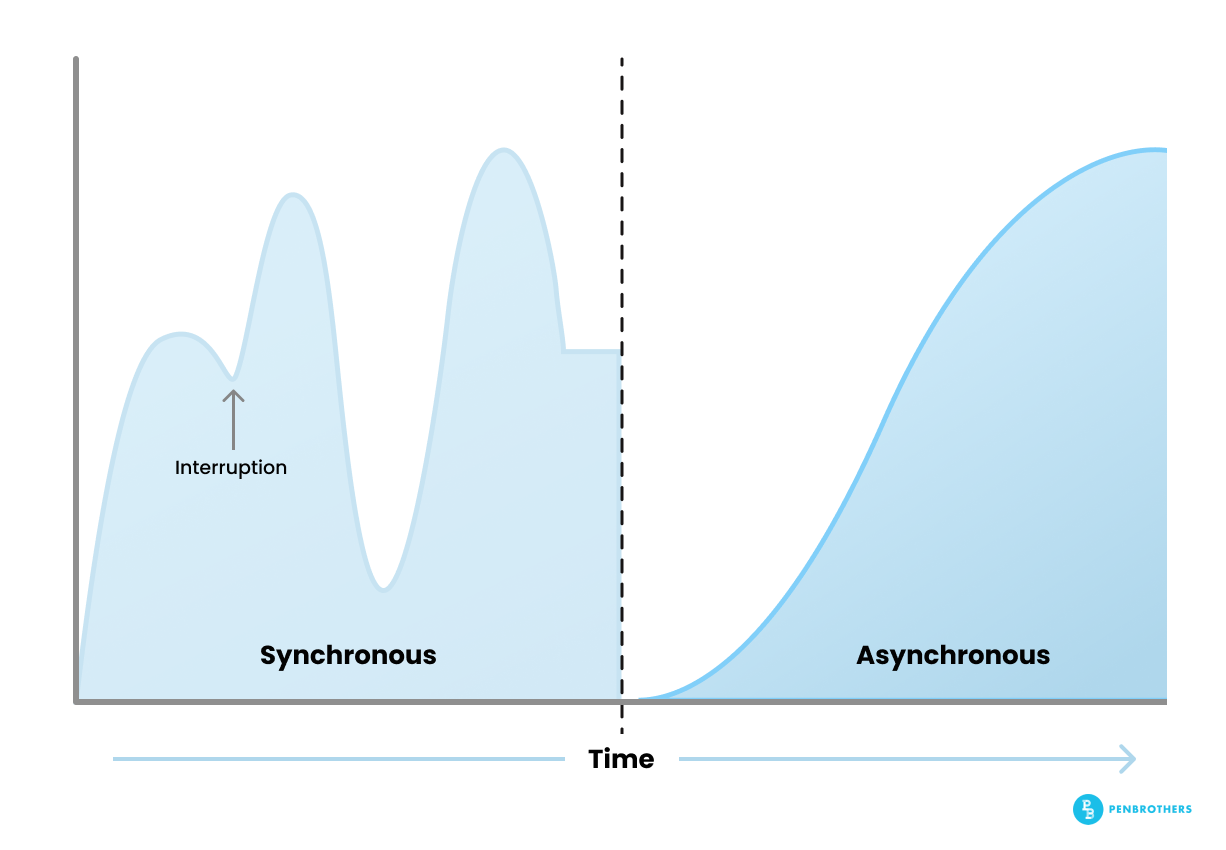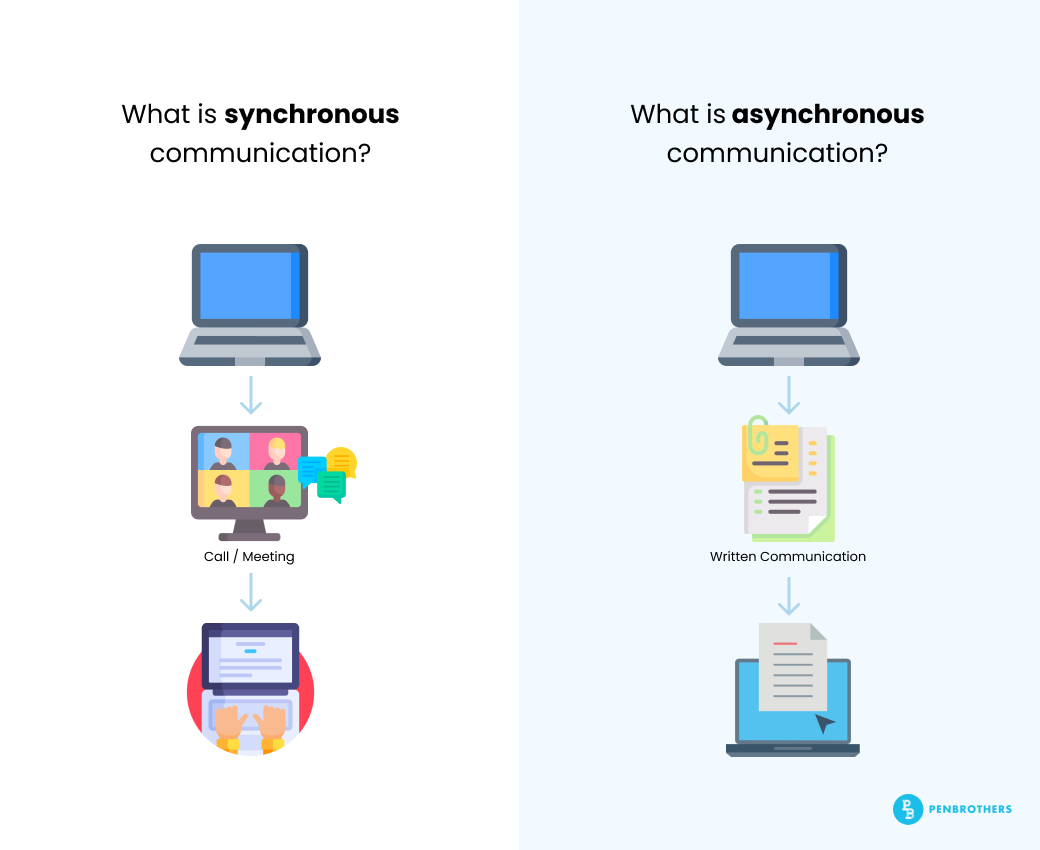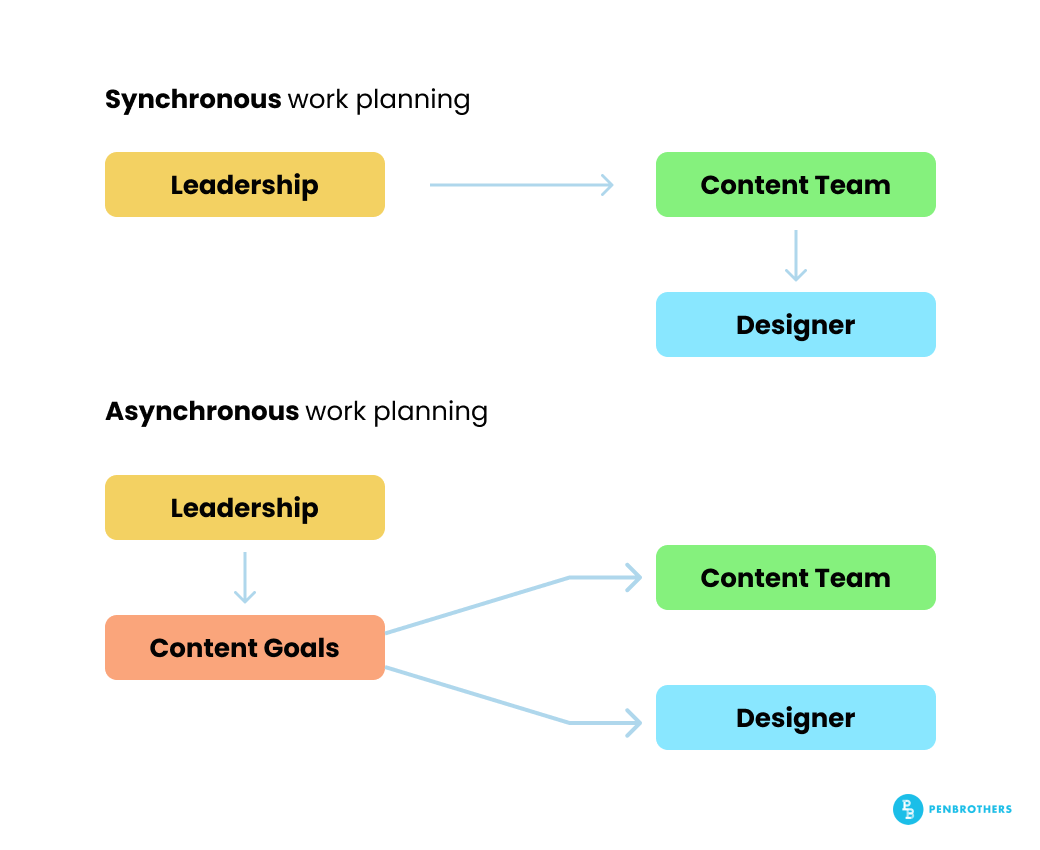What's Inside?
Why You Should Start Working Asynchronously

Business has changed. The old 9-to-5 schedule can’t keep up. Today’s companies collaborate across cities, continents, and cultures. With teams scattered globally, time zones clash, meetings overflow, and real productivity suffers.
In a world demanding speed and flexibility, asynchronous work isn’t just a good idea—it’s a competitive edge.
At Penbrothers, we see it daily: asynchronous strategies unlock hidden efficiencies for companies building offshore teams. The demand for this model is no longer a preference; it’s a core retention strategy. According to Owl Labs’ 2025 State of Hybrid Work report, flexibility is paramount: 40% of workers would start job hunting if flexible work were taken away. Check out how we build effective offshore teams that thrive in async environments.
Check out how we build effective offshore teams that thrive in async environments.
Key Takeaways
- A Strategic Shift in How Work Gets Done: Asynchronous work is a model where team members collaborate without the requirement to be online at the same time. It is a strategic shift away from a “presence equals productivity” mindset, empowering employees to work when they are most effective rather than adhering to a rigid 9-to-5 schedule.
- The Core Benefits are Productivity, Talent Access, and Satisfaction: The primary advantages of an asynchronous model are boosted productivity (by protecting deep focus and reducing interruptions), access to a global talent pool (by eliminating time zone barriers), continuous 24/7 progress on projects, and increased employee satisfaction and retention.
- Requires a Foundation of Trust and Documentation: An asynchronous model cannot function without two key components: a culture of trust and autonomy (shifting from managing hours to managing outcomes) and a strong commitment to clear, thorough documentation of all decisions, processes, and updates to prevent knowledge gaps.
- Async-First, with Synchronous for Key Moments: The most effective approach is to be “asynchronous-first,” using tools like project boards and shared documents as the default. Synchronous (real-time) communication, such as meetings, is then reserved only for high-value, necessary interactions like complex brainstorming or handling urgent blockers.
What Is Asynchronous Work?
Asynchronous work means teams don’t need to be online at the same time. They collaborate when it suits them. They communicate through tools like email, project boards, cloud drives, and shared documentation.
It’s about flexibility in time, not just flexibility in location.
Remote work simply means you can work from anywhere; asynchronous work means you can work whenever it makes the most sense. Unlike traditional synchronous models — where meetings, handoffs, and approvals happen live — async-first organizations empower individuals to move independently, without being blocked by others’ schedules.
In fact, 2025 data from Gallup clarifies the impact of this future: fully remote employees report the highest levels of engagement (31%), demonstrating that well-implemented remote structures are a powerful performance driver.
At its core, asynchronous work rests on three principles:
- Autonomy: Trust employees to own their schedules and deliver results without micromanagement.
- Clear Communication: Prioritize documentation of decisions, workflows, and progress to avoid knowledge bottlenecks.
- Action Over Waiting: Encourage proactive movement forward—even without immediate feedback or approvals.
Async work doesn’t just solve logistical problems like time zone differences.
It transforms culture. By shifting away from the outdated mindset of “presence equals productivity,” companies unleash deeper work, reduce burnout, and scale faster across borders.
At Penbrothers, we’ve seen how global offshore teams thrive when asynchronous principles are embedded from day one — turning flexibility into a long-term business advantage.
The Strategic Benefits of Asynchronous Work
1. Global Talent Access
Asynchronous work unlocks the world’s talent pool. Without the need for overlapping work hours, businesses are no longer limited by time zone barriers when building their teams. Companies can hire the best candidate for the job, regardless of where they live — opening doors to diverse skills, fresh perspectives, and stronger innovation pipelines.
At Penbrothers, we see this advantage play out daily. Our clients seamlessly integrate top-tier Filipino talent with teams based in the US, Europe, and Australia, without waiting for real-time collaboration windows. Asynchronous workflows make global integration smoother, faster, and more productive — ensuring that the sun never sets on your company’s progress.
2. Boosted Productivity and Flow
When teams work asynchronously, they protect one of their most valuable assets: deep focus. Constant interruptions — whether through excessive meetings, unnecessary pings, or forced real-time collaboration — break momentum and lower output quality. Asynchronous structures allow employees to batch communications, focus longer, and enter “flow” states — a condition of peak creativity, concentration, and performance that fuels true innovation.
Research highlights the high cost of these interruptions. A study by Harvard Business Review found that the average digital worker toggles between apps nearly 1,200 times a day, spending almost 4 hours per week just reorienting themselves. This ‘toggle tax’ shatters deep focus. By minimizing real-time demands, asynchronous work creates an environment where creative and technical talents can perform at their highest levels.

The above illustration shows that Interruptions break our flow and slow productivity. Asynchronous work protects deep focus by minimizing unnecessary disruptions. Companies that master this balance don’t just move faster — they move smarter.
3. Increased Employee Satisfaction
Employees aren’t machines; their energy levels peak at different times of the day. While some do their best work at sunrise, others hit their creative stride in the evening. Asynchronous work respects these natural rhythms, allowing individuals to plan their days around when they feel most productive — not when a meeting scheduler demands it. This freedom significantly boosts both morale and output quality.
For instance, while autonomy is key, 2025 data highlights that digital overload is a primary driver of modern burnout; 69% of remote employees report increased burnout from digital communication tools. Asynchronous work directly counters this by shifting the focus from “always on” to “on when effective.” This control over when to engage is critical. In fact, Gallup’s 2025 reports confirm that the most engaged employees are those who have this control, leading to higher loyalty and productivity.
Happier employees aren’t just more productive; they’re also more loyal, collaborative, and invested in the long-term success of the company — a win-win for both talent and leadership. Read how our people-centered culture enhances team satisfaction.
4. Continuous Progress
Traditional project management often grinds to a halt when key players are unavailable. Asynchronous workflows turn this model upside down. When one team wraps up their day in Sydney or Manila, another team in New York or London picks up the baton. Progress becomes a continuous relay, not a stop-and-start marathon waiting for morning stand-ups or live syncs.
At Penbrothers, we’ve helped companies fully leverage this advantage. Philippine-based developers, designers, and customer service teams routinely move projects forward overnight while clients in the West recharge. The result? Faster delivery cycles, higher responsiveness to client needs, and a competitive edge in markets where speed-to-execution matters.
The Common Challenges (and How to Overcome Them)
Delayed Feedback
One of the natural challenges in asynchronous work is slower feedback loops. Without immediate responses, projects can temporarily stall, decisions may take longer, and momentum might slip if teams aren’t careful. Especially for tasks requiring quick approvals or clarifications, waiting for input can be frustrating and can negatively affect project timelines if not managed well.
The solution is setting clear expectations for response times across all communications. Many asynchronous organizations successfully implement a 24-hour reply standard — fast enough to keep projects moving, but flexible enough to respect different time zones and work styles. At Penbrothers, we coach offshore teams and their managers to establish realistic yet responsive communication guidelines from the start, ensuring that async work doesn’t mean “wait forever work.”
Task Dependencies
Task interdependencies can complicate asynchronous workflows. If one deliverable hinges on another team member’s progress, even minor delays can cause cascading bottlenecks across projects. In traditional synchronous environments, a quick call or desk chat might resolve these; in async-first settings, such informal nudges don’t happen as easily.
To overcome this, teams must rely heavily on proactive documentation. Every task should be broken down clearly with full context, well-defined goals, expected outputs, deadlines, and escalation paths if issues arise. At Penbrothers, we guide clients and remote teams to treat documentation not as a side task, but as a core function of collaboration — ensuring that work continues moving forward without unnecessary blockers.
Self-Discipline Issues
Without the physical presence of supervisors or colleagues, some team members may struggle to stay focused. Household distractions, social media, or simple procrastination can creep in when people are given full control over their schedules. This lack of structure is often cited as one of the biggest fears among leaders adopting asynchronous models for the first time.
The best approach is to hire for autonomy — selecting individuals who have a proven ability to manage their own time, prioritize tasks, and deliver consistently without constant oversight. Self-discipline can also be nurtured through time management training and by shifting performance metrics from “hours worked” to “outputs delivered.” When Penbrothers builds offshore teams, we place a strong emphasis on independent work habits during recruitment, onboarding, and continuous support, helping clients assemble teams that don’t just survive async work — they thrive in it.
Async vs. Synchronous Work: When Each Makes Sense
Asynchronous should be your default. But that doesn’t mean synchronous work is obsolete. The key is understanding when and why to use each. Async work is about untethering progress from presence — allowing people to move forward without waiting on real-time input.
It eliminates artificial blockers like time zone mismatches or calendar clashes, which often slow down globally distributed teams.
In async environments:
- Employees don’t need to be online at the same time.
- Progress isn’t dependent on quick responses or constant status updates.
- Work moves faster, thanks to documentation, transparency, and trust.
Synchronous work, on the other hand, ties progress directly to live communication.
Need a quick answer and someone’s offline? You wait. Need approval and your manager’s in another time zone? You pause. This model can be effective in small doses, but used too often, it creates friction — not flow.
That said, synchronous communication still has its place.
Use synchronous methods when you:
- Need real-time brainstorming that benefits from rapid feedback and creative energy
- Onboard new hires who require structured, real-time support to ramp up quickly
- Troubleshoot urgent blockers where delays would stall production

The smartest companies structure their workflows to be asynchronous by design — with clear documentation, defined timelines, and shared ownership. But when the moment truly calls for it, they pick up the phone, hop on a call, or jump into a live session. Not by default — by necessity.
GitLab found that 52% of remote workers reported being more productive, and 48% felt more efficient in an all-remote, asynchronous environment.
In async-first organizations, meetings become intentional, not habitual. Progress becomes continuous, not conditional. And collaboration becomes truly global — not just remote.
Key Components of a Successful Asynchronous Workflow
1. Multiplexing
Multiplexing refers to the ability to move multiple pieces of work forward independently — without waiting on someone else to go first. In traditional (synchronous) workflows, one step must finish before the next can begin. If a bottleneck appears, the whole timeline stalls. But with an asynchronous structure, tasks are broken into smaller, standalone units so progress can happen in parallel.
Take a marketing campaign, for example. As seen in the below diagram, in a synchronous setup, the designer waits for final copy from the content team, and the content team waits for strategic direction from leadership. Everything happens one after another — slow, rigid, dependent. But in an asynchronous workflow, leadership outlines campaign goals in a shared doc, the content writer drafts based on that, and the designer starts mocking up visual layouts using placeholder text. Everyone moves at the same time. You launch sooner, refine quicker, and iterate faster.

Async multiplexing isn’t just more efficient — it turns waiting time into working time.
2. Clear Communication
Communication is the glue that holds asynchronous workflows together. When you can’t rely on real-time clarification, your written and visual communication must be airtight. That means documenting decisions, using shared wikis, and writing messages that are self-contained, clear, and actionable.
Async-first teams prefer structured tools: Notion, Confluence, Slack, Asana, Trello. But tools alone aren’t enough — the team needs to agree on expectations. What counts as “urgent”? When is a response expected? Penbrothers encourages its offshore teams to use a “document before discussion” principle: clarify through writing first, sync later if needed. That reduces the need for recurring calls and builds a searchable knowledge base for future hires.
3. Proactive Action
Asynchronous teams thrive when people default to action. In traditional environments, workers often wait for instructions, feedback, or meetings before moving forward. In async organizations, the expectation is reversed: if something’s unclear, take initiative. Move to the next task. Make a decision based on what’s available. Waiting is the real risk.
At Penbrothers, we coach offshore hires to think like owners — especially when instructions are delayed. Let’s say a product manager is offline and hasn’t yet defined a specific feature. Rather than stall, an async-minded developer might document assumptions, tackle a different task, or prepare a proposal in the meantime. As Remote puts it: “It’s not about ignoring risk — it’s about taking charge in a controlled way.” This culture of responsible autonomy is what makes async teams not just functional, but high-performing.
Best Practices for Implementing Asynchronous Work
- Set clear guidelines
Async doesn’t mean “answer whenever.” Without clarity, even the best teams can get stuck in limbo.
Establish specific expectations for how quickly people should reply — whether that’s within 4 hours, 12 hours, or one business day.
This standardization removes ambiguity and empowers team members to plan their day without fear of missing something “urgent.” It also helps avoid burnout from the pressure of always being on. A shared understanding of timelines makes async smoother, calmer, and more respectful of everyone’s time.
- Collaborate using tools
The async stack matters. Use shared platforms like Notion, Trello, Asana, Loom, or Google Workspace to give teams full visibility into projects, timelines, and tasks.
Even better, integrate your systems — documentation, messaging, and project management — so nothing falls through the cracks.
When used well, these tools eliminate the need to constantly ask “what’s the status?” or “who’s doing what?” At Penbrothers, we help clients build offshore teams that thrive on transparency — and that starts by making the work visible, not hidden in Slack DMs or siloed inboxes.
- Minimize meetings
Meetings aren’t bad — but unearned meetings are. Default to async updates using written memos, video walkthroughs, or collaborative documents. Save live sessions for high-impact moments: tough decisions, brainstorming, or serious blockers.
By minimizing sync time, you create space for deep work — and you show respect for your team’s focus. Async-first teams meet less but align better, because they prioritize clarity before conversation.
- Document decisions
Async teams rely on written memory. Every key decision, lesson learned, or recurring process should live in a searchable, shared place.
This not only helps new team members ramp up faster, but it ensures progress continues even when someone’s offline. Documentation turns knowledge into infrastructure — it’s how remote teams scale without chaos.
- Foster trust and self-management
Without trust, async fails. Micromanagement kills autonomy, and autonomy is the foundation of effective async collaboration.
Empower team members to structure their day, own their work, and deliver on outcomes. That means shifting from time-based management (“Were they online at 9 AM?”) to results-based management (“Did they ship what was promised?”).
Many remote workers report feeling more trusted when given autonomy over their schedules—a hallmark of asynchronous work. In fact, Owl Labs’ 2025 State of Hybrid Work report confirms this: 92% of employees now value a supportive, trusting manager almost as highly as pay. This culture of trust is the non-negotiable foundation for the autonomy async work requires.
- Continuously refine policies
Asynchronous work isn’t a “set it and forget it” model. It’s a living system that evolves with your team’s needs.
Gather feedback regularly. Audit your tools. Watch for friction points. Ask: “Where are people defaulting to sync, and why?” — and then iterate. At Penbrothers, we guide clients through async adoption by making small, continuous changes that compound over time.
These practices aren’t reserved for tech startups. They apply to any company with a globally distributed team — from finance to customer support to creative agencies.
And with the right offshore partner like Penbrothers, you can adopt asynchronous systems that don’t just support remote work — they make it thrive. Learn how asynchronous collaboration is redefining the workplace.
What is an Example of Asynchronous Work?
The clearest example is the difference between a “status update meeting” and a “status update document.”
A synchronous (traditional) approach involves scheduling a 60-minute meeting. The team waits for this meeting to share progress. During the meeting, six people listen while one person speaks, and discussion is limited by the clock. Work halts for the meeting, and project velocity is blocked by calendar availability.
An asynchronous approach replaces the meeting entirely.
- The project manager maintains a shared document or project board (like Trello or Asana).
- By end-of-day Monday, each team member adds their updates: what they’ve completed, what they’re working on next, and any blockers.
- Team members in other time zones (like an offshore team from Penbrothers) review the updates, add their own, and post solutions or questions related to the blockers.
- By Tuesday morning, the entire project status is documented, reviewed, and advanced—all before the manager has had their first cup of coffee.
This “document-first” method, a core Penbrothers practice, creates a searchable record, eliminates time zone friction, and lets every team member contribute thoughtfully, not just quickly.
What Jobs Are Asynchronous?
While any role can adopt async practices, some jobs are naturally structured for it. These roles typically involve high levels of deep work, clear deliverables, and a focus on output over “presence.”
At Penbrothers, we find that offshore teams in these roles thrive in async environments:
- Software Engineers & Developers: Code is the ultimate async communication. Developers can work on feature branches, submit pull requests, and conduct code reviews entirely on their own schedules.
- Designers (UI/UX, Graphic): Creative work demands long, uninterrupted blocks of focus. Async models allow designers to work when they are most creative, sharing mockups and prototypes via tools like Figma for feedback at a later time.
- Content Writers & Marketers: Drafting articles, social media campaigns, or SEO strategies is solitary work. A clear brief (the “documentation”) is all that’s needed for a writer to produce a full draft.
- Customer Support (Tier 2/3): While Tier 1 support is often synchronous (live chat), complex ticket escalations are perfect for async. A support specialist can investigate a complex issue, document the findings, and provide a solution without needing a live handoff.
- Data Analysts: Analysts take a query or a problem, go deep into the data, and emerge with a report. This process is highly independent and benefits from the focused time that async work protects.
The key isn’t the job title, but the workflow. If a job’s success is measured by the quality of the deliverable—not by responsiveness on Slack—it’s a prime candidate for an asynchronous workflow.
Final Thoughts
Businesses that embrace asynchronous work win. They innovate faster, attract better talent, and scale across borders without scaling chaos.
At Penbrothers, we help companies around the world adopt async-friendly models by building offshore teams that are not only highly skilled but highly self-directed.
Because the future of work isn’t chained to a clock. It’s distributed. It’s autonomous. And it’s asynchronous.
Ready to see what a high-performing, async-powered team can do for your business? Let’s talk.
Frequently Asked Questions
Asynchronous work is a collaboration model where team members can contribute to a project, communicate, and complete tasks on their own schedules, without the need to be working at the same time. It relies heavily on digital tools, clear documentation, and individual accountability.
Remote work simply means you can work from anywhere. Asynchronous work means you can work at any time. Many remote jobs are still synchronous, requiring you to be online for meetings and calls from 9-to-5 in a specific time zone. An asynchronous job is fully flexible, trusting you to deliver results on your own schedule.
The most common challenges are delayed feedback loops (waiting for responses), managing task dependencies (when one person’s work is blocked by another’s), and the need for employees to have strong self-discipline and time management skills to stay productive without direct supervision.
A great example is replacing a live, one-hour “status update meeting” with an asynchronous document or project board task. Instead of everyone stopping their work to attend the meeting, each team member adds their updates (completed tasks, next steps, and blockers) to the shared document by the end of their day. Team members in other time zones can then review the updates and add their own, allowing the project to move forward 24/7.
Jobs that are deliverable-focused and require long periods of deep, uninterrupted work are a natural fit. The best examples include Software Engineers, Designers (UI/UX or Graphic), Content Writers and Marketers, Data Analysts, and many Tier 2/3 Customer Support roles that involve complex ticket investigation.
*This article was crafted with the support of AI technology and refined by a human editor.





